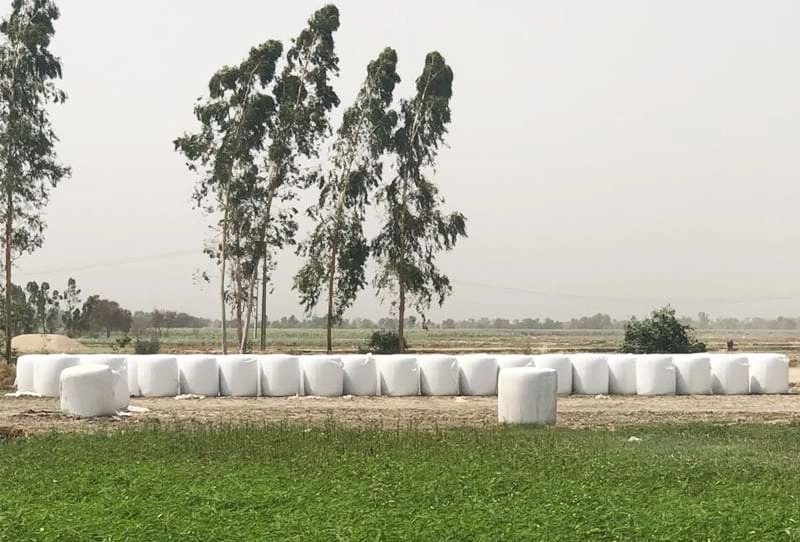
Silage film is a high-strength, flexible plastic used primarily in the agricultural sector to preserve forage crops such as grass, corn, and alfalfa. These films serve as protective layers, sealing silage in silos, bales, or stacks to prevent exposure to air, moisture, and microorganisms. By maintaining an anaerobic environment, silage film ensures the forage undergoes proper fermentation, preserving its nutritional quality and extending storage life. Typically manufactured from polyethylene, silage films are designed with multiple layers to combine tensile strength, puncture resistance, and UV protection, providing farmers with a reliable solution for long-term silage storage.
Unlike ordinary plastic wraps, silage films are engineered specifically for agricultural applications. Their ability to stretch and conform to the shape of bales or stacks creates a tight seal that limits oxygen penetration, a critical factor in preventing spoilage and mold formation. This innovative material helps reduce feed loss, improve livestock health, and optimize farm productivity. In modern agriculture, the selection of high-quality silage film can significantly impact farm efficiency and sustainability.
Key Applications of Silage Film
Silage film is widely utilized in the storage and preservation of forage crops. Its primary applications include:
Bale Wrapping: Silage film is commonly used to wrap round or square bales. The film protects against air and water ingress, ensuring the silage ferments correctly.
Silo Covering: For silage stored in bunkers or trench silos, silage films act as covers to maintain anaerobic conditions.
Stack Protection: Loose piles of forage can be covered with silage film to prevent spoilage from rain, wind, and sunlight.
Each of these applications requires specific properties from the silage film. For example, bale wrapping demands high elasticity and puncture resistance to handle machinery and uneven bale surfaces. On the other hand, silo covering emphasizes UV resistance and thickness for durability. Choosing the right silage film for the intended application ensures maximum feed preservation and cost-effectiveness.

Benefits of Using Silage Film
The use of silage film offers multiple advantages to farmers, including:
Reduced Feed Waste: By sealing the forage tightly, silage films minimize aerobic spoilage and mold growth.
Improved Nutritional Quality: Proper fermentation maintains essential nutrients like proteins and vitamins.
Enhanced Livestock Health: Fresh, well-preserved silage improves feed intake and animal growth.
Weather Resistance: UV-stabilized films endure prolonged exposure to sunlight, rain, and wind.
A quality silage film not only protects the silage but also contributes to sustainable farming by reducing losses and improving feed efficiency.
Common Types of Silage Film
Silage films are typically categorized based on material composition and performance characteristics. The table below summarizes the main types:
| Type | Material | Thickness | Key Feature |
|---|---|---|---|
| Single-layer PE | Polyethylene | 25–30 µm | Economical, flexible |
| Co-extruded multi-layer | PE/PA/PE | 50–75 µm | High tensile strength, puncture resistance |
| UV-stabilized | PE with UV additives | 25–50 µm | Prolonged outdoor durability |
Selecting the appropriate type depends on environmental conditions, storage duration, and forage type. Multi-layer films are preferred in harsh climates or long-term storage, while single-layer films are suitable for short-term or small-scale applications.
How to Use Silage Film Effectively
Proper application of silage film is crucial for maximizing its performance. Key steps include:
Surface Preparation: Ensure that the forage stack or bale surface is smooth and free of sharp objects.
Correct Wrapping Technique: Apply the film tightly with uniform overlap to create an airtight seal.
Layer Management: Use multiple layers if necessary, especially in outdoor storage, to increase protection against punctures and UV degradation.
Storage Maintenance: Monitor and repair any tears or holes promptly to prevent spoilage.
Proper handling and storage practices not only extend the life of the silage but also optimize feed quality for livestock.
Silage Film FAQs
Q1: Can silage film be reused?
A1: Generally, silage film is designed for single-use applications. Reusing film can compromise its integrity and reduce effectiveness in sealing silage.
Q2: What thickness of silage film is recommended?
A2: Thickness typically ranges from 25 µm to 75 µm. Outdoor storage or longer-term preservation may require thicker, multi-layer films.
Q3: How long can silage film preserve forage?
A3: With proper application, silage film can preserve forage for several months to over a year, depending on storage conditions and forage type.

Environmental and Safety Considerations
While silage films are essential for modern agriculture, proper disposal and recycling are critical. Many silage films are made from polyethylene, which is non-biodegradable. To reduce environmental impact, farms are encouraged to:
Recycle Used Films: Work with local recycling programs to process used film.
Use Eco-friendly Alternatives: Some manufacturers offer biodegradable or partially compostable films.
Prevent Wildlife Hazards: Avoid leaving loose films in fields to prevent ingestion by animals.
Adhering to environmental guidelines ensures that silage film use is sustainable and responsible.
Conclusion
Silage film plays a vital role in modern agriculture by preserving forage, improving livestock nutrition, and reducing feed loss. Understanding its applications, proper usage, and environmental considerations enables farmers to make informed choices, enhancing both productivity and sustainability. Investing in high-quality silage film and following correct handling procedures ensures optimal fermentation, long-term storage, and improved farm efficiency.
By integrating silage film into daily agricultural practices, farmers can achieve significant benefits in feed preservation and overall operational effectiveness, making it a cornerstone of efficient forage management.









